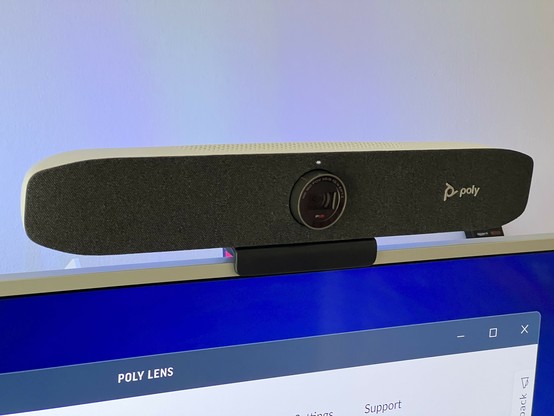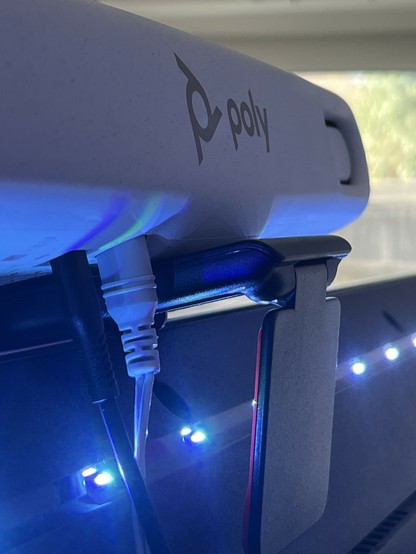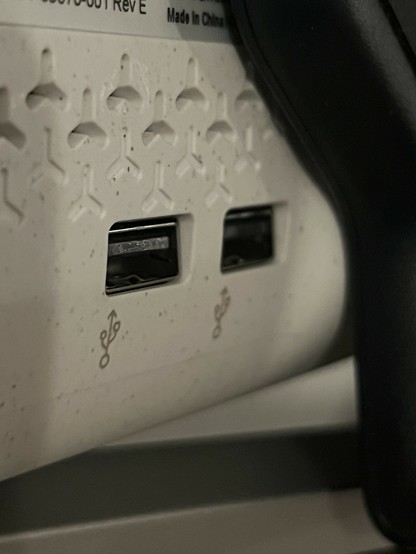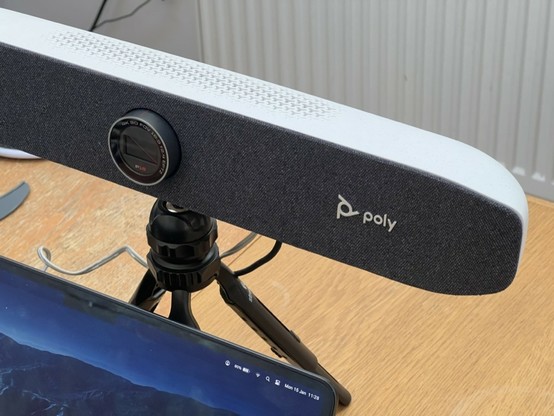Poly Studio P15 Video Bar Reviewed
When the great COVID upheaval first struck and us humble pencil pushers and keyboard jockeys were sent home to find a safe, virus-free nook to work in, the webcam industry was not prepared. Fast-forward some four years and things have changed, but not really by much. While webcams have stepped up their game, and are rather easier to get hold of, they exist in a precarious position, poised on the precipice of obsolescence.
Why? It’s our old friend smartphones again. In 2022 Apple launched Continuity Camera and Google is playing catch up by adding a webcam feature to Android 14 available on select phones- granted you can just use scrcpy and v4l if you’re a Linux user.
But the smartphone-as-a-webcam prospect isn’t quite so elegant as the smartphone-as-a-camera. At best you’ve got to fumble your phone onto whatever mount you’ve got set up, and at worst you might simply broadcast a high-definition feed of your nostrils. In either case, if you’ve got the propensity to fidget, or simply need to field incoming messages on your phone- it being tied up as a webcam doesn’t really help. I guess the implication is that you’ll use your old phone as a camera- but you traded it in, right? Right? You don’t have three in a drawer somewhere!?
For those of us who are slightly more technically inclined, quality-obsessed or just desperate to find a use for that mirrorless camera we swore we’d carry everywhere then a permanent setup can be contrived with an HDMI capture card (or USB cable if you have a really fancy camera), a microphone and some headphones. This is the setup I’ve been using for some years now- an EOS M3, and whatever microphone and headphones I happen to be testing at the time. There’s a downside to this setup, too. It’s bloomin’ complicated. More than once has my weekly team videocall been sabotaged by some device (usually my headphones, but not always) deciding that it’s going to be finicky and weird and uncooperative. Even when everything works great, powering up my camera, removing the lens cap, correcting the focus (auto focus, even with CHDK custom firmware, shows pesky on-screen tracking markers), swinging forth my boom mic, donning my headphones and dropping exasperated (and a few minutes late) into a call has been such a nuisance I’m more often than not prone to simply join from my phone.
The Poly Studio P15- when you absolutely positively got to film every mother flipper in the room, accept no substitutes.
And after this long introduction- enter the Poly Studio P15. The conceit of this hulking great videobar is simple- handle all your video-conferencing needs in one, concise, reliable device that you can set and forget.
Does the P15 deliver? Yes. Is it worth the rather steep £240 price? Maybe. Would I throw away my convoluted set up and use one? Yes, after a few successful video calls and an episode of Tom’s Hardware Pi Cast under the P15’s belt, I’m pretty happy with it. Though, admittedly, it’s quite substantially overkill for my needs.
Perhaps the biggest strength of the Poly P15 is that hulking great size. As you might have guessed from its fetching fabric fascia the P15 conceals a speaker and an array of microphones. Not only does this make conversing with your peers a fairly natural and unencumbered experience, but that speaker – and yes, unfortunately there’s only one – is more than punchy enough as a replacement for desktop speakers for casual YouTube watching or Podcast listening. This means you’ll easily find something for it to do when not you’re videocalling with the P15, which softens the blow of that price tag just a little.
The microphone array is for echo cancellation, and does a frankly incredible job of handling voice calls even with the on-board speaker blasting out at a mid to high volume. With a custom contrived setup I always ran the risk of feeding back everything anyone said into the group chat and you’d be surprised how big a problem this can be when you need to crank your headphones to hear the folks mumbling into the call from one desk over.
The P15 liberates you from headsets in a one to many conversation, but it’s also a much better prospect if multiple people want to join in a video call. You might not do this from your home office during a work meeting, but it could be handy for that regular call to your friends or family abroad, letting you rope everyone in your household into the chat.
Using exclusively the P15’s speakers, microphones and video to conduct my Very Business Internet Calls for the last few weeks resulted in some of the few times I haven’t been muted or complained at for having some weird audio problem. With the P15 I could plug one thing in, switch the microphone and video inputs in Google Meet and be up and running in moments. When the call was done I could give the camera a little twist to engage the privacy shutter and be assured that some ghost in the machine isn’t watching me pick my nose.
Stuck above my TV the Poly Studio P15 could see a disturbing amount of my living room, but mostly focussed on my face and gave a pretty decent crop. Alas the angles didn’t work out for my debut Punch & Judy video call appearance.
Some fun was had, too, with the P15’s ability to pan or crop its wide-angle view of a space automatically, picking out and framing my face at a modest pace and with a reasonable degree of customisability. Apple call this concept “Center Stage”, and it makes a lot of sense for more meeting-room style setups with multiple participants, but outside of the sheer novelty I found it somewhat irritating. The reframing is slow enough that I can disappear out of shot and have to wait for it to catch up, and also there are times I might want to duck out of shot, or rooms I might set up a camera in that really don’t lend themselves to a wide-angle vista of ADHD chaos.
Fortunately the Poly Lens software- while it doesn’t work on Linux at all- gives the ability to fine tune auto panning options, including turning them off completely and picking a fixed crop at which the camera will stay. I hooked up my Mac, tweaked the camera settings to suit my office, and then switched the camera back over to my Linux workstation. Thankfully the custom settings were saved on the camera somehow and- as far as I can tell- even persist if it’s disconnected from power.
On the topic of software, you’re probably going to need to interact with the Poly Lens app to tame the P15 and adjust some other settings. Thankfully it has a “Guest” option, avoiding the need to set up yet-another-darn-account. The camera options have a live preview you can enable to see what effect your tweaks have. Audio options include “Acoustic Fence” which attempts to detect speech within a certain spatial area- defined as wide, medium, narrow or “camera view”. These regions are horizontal only, and offer a 60, 90 or 120 degree region (or dynamic in the case of “camera view”) within which the microphone will detect speech and mute/unmute accordingly. I don’t have the luxury of a busy office to test how well it works, but judging by the amount of the P15 dedicated to microphones I’d suspect it’s pretty competent.
Beneath its fabric exterior- held on with plastic pegs that slide into rubber grommets to isolate vibrations - there’s a slick white speaker driver and multiple microphones.
I think I probably have to admit that the P15 is quite substantially overspecified for my requirements. I like having a high quality camera above all else, and value silly things like a narrow depth of field- the P15 is less focussed on visual fidelity (especially when it zooms right in) and more focussed on making it easy for two or three people to engage in the same meeting with a single setup. I’ll grant that the P15 is quite significantly simpler to set up than a separate speaker, camera and microphone and much less prone to failure and misbehaving. This has let me, for example, stick it above the TV and struggle to tidy enough of the living room for its wide, wide lens.
Its biggest drawback is a small one; the Studio P15 requires a separate, 36W power supply. Most of that power is probably for its surprisingly loud speaker. It makes up for this somewhat by additionally acting as a USB hub, though there are precious few devices you might want to plug in there. Anything you might need to access will upset your, presumably carefully poised, camera. The specs suggest a wireless headset adapter, and this is probably a good example. Add a keyboard and mouse, too, and you’re tantalisingly close to a single-cable dock. As such it would have been nice to beef up the P15’s power supply and go the distance as a full A/V laptop docking solution. Y’know, cos you’re more than likely to want to stick one in a meeting room and hook up a laptop so it’d be great if it worked for power too.
Needing a power supply does out a damper on the cable simplicity of a combined speaker/camera/microphone, but it’s a fair trade for surprisingly punchy sound and a couple of USB ports.
The P15 came with a USB (3.0) Type-C to Type-C cable, which is probably the sensible choice these days. Of course I wanted to use a USB Type-A port so I just grabbed the nearest Type-C to Type-A cable and it worked fine. Suffice to say, a webcam, microphone and speakers – almost in spite of the P15’s large size and professional looks – don’t really tax USB all that much. Especially since the webcam tops out at 30FPS.
Sticking a tripod on the Poly Studio P15 lets me poke it over my laptop without having to precariously balance it on the screen.
The monitor-top mount uses a standard tripod thread, so you can use a mini tripod to put the P15 on a table-top or even a full-sized tripod or wall-mount for the far end of a conference room. I borrowed the tripod from my Endgamegear ring light, which handily peeked the P15 just over the top of my MacBook Air.
So is it worth it? If you’re a small to medium business making regular video calls with clients, teams or folks working from home then it would be an excellent choice. Ironically the P15 would make a much, much bigger impact to my quality of life on weekly calls if I took it into the office and left it there. With just me on this end then the simplicity of setup and the lack of all the usual pesky problems that plague my piecemeal audio visual gear isn’t quite enough to justify the P15 over just abandoning that complexity and hopping on a call with my iPhone. I guess that’s why it’s a “Professional Video Bar” and not a “Some Code Monkey In A Home Office Video Bar.” If you’re a stickler for visual fidelity then the P15 isn’t going to push the boat out- you’ll get markedly better results and that tantalising narrow depth of field just using Continuity Camera via your iPhone. Just look at me versus spookyjon on the Tom’s Hardware Pi Cast.





